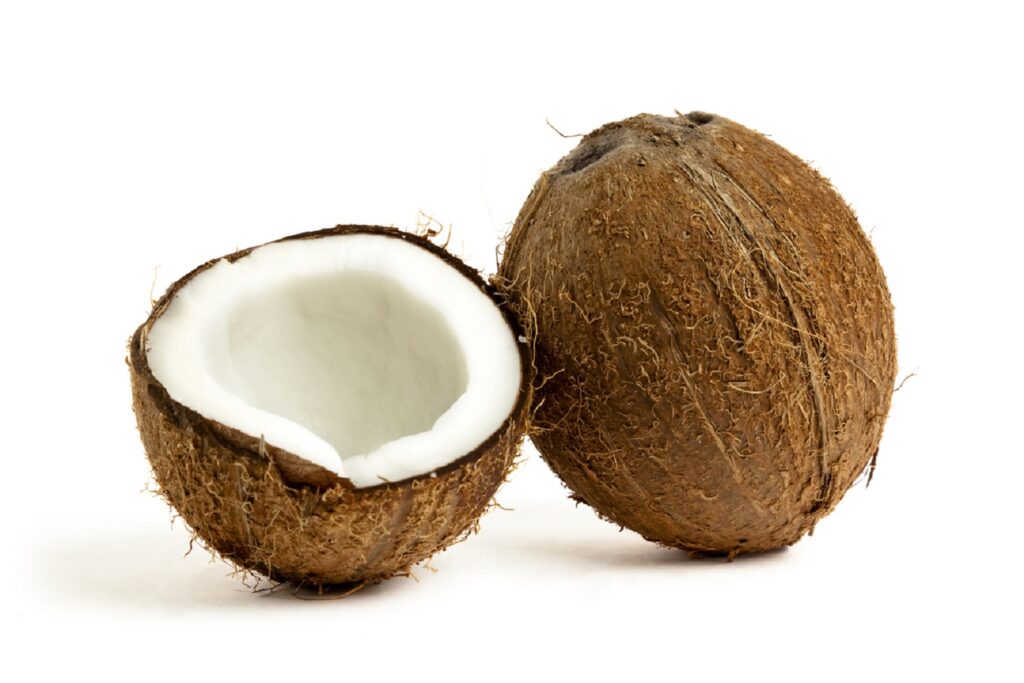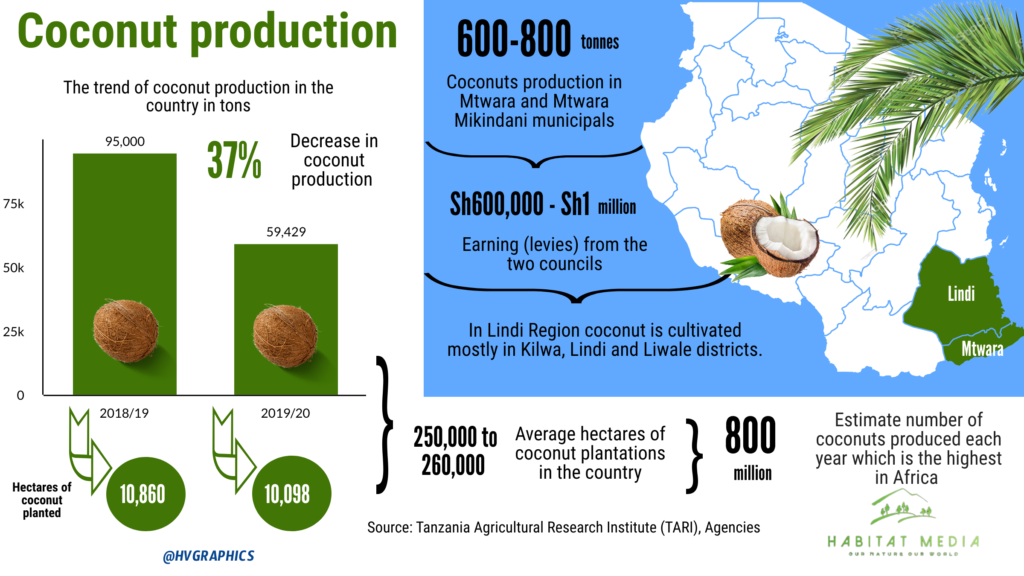Challenges, opportunities of Coconuts farming in Southern East Tanzania
By Haika Kimaro

Mtwara. Cashewnuts and sesame are major crops which come to mind of many people when talking about commercial agriculture in Mtwara and Lindi regions. Many people are not aware that coconut farming is one of major undertaking by many people in the two regions. In some places, coconut farming used to outpace cashewnuts and sesame by far in terms of income to farmers.
Coconuts can be regarded as a sustainable crop as one can harvest three or even four times a year in a tree. This crop is harvested year round and the tree survives for many years.
In Mtwara, coconuts are popular in Mtwara and Mtwara Mikindani municipalities where annual production stands at around between 600 and 800 tonnes. From this the two councils earn between Sh600,000 and Sh1 million a month from levies.
In Lindi Region coconut is cultivated mostly in Kilwa, Lindi and Liwale districts. Data shows that in the 2018/19 season, some 95,000 tonnes were harvested from 10,860 hectares but in 2019/20 production decreased to 59,429 from 10,098 hectares.
According to villagers in Ng’apa in Lindi District, they pay Sh20 for every coconut they sell meaning that in 2018/19 the region should have earned an average of Sh954 million while in 2019/20 levy from coconuts should have been Sh594 million.
Coconut is majorly used to produce cooking oil while its shells are used as firewood and can be made into ornaments. Its husks can be made into various products such as ropes and baskets. Unripe coconut is a famous food and drink in coastal areas.
Abdulrahman Ally, one of coconut farmers from Ng’apa village, which leads in coconut production in Lindi Region, says that his living solely depends on coconut farming.
He said in the past they used to earn handsomely from the crop but from the 2021 season the price of the crop has plummeted. He said in the past a coconut earned them up to Sh600 while now they can hardly negotiate Sh200 for a coconut.
“In the past prices used to drop during the rainy season but in recent years even in the dry season the price is not promising. We have a lot of stock of coconuts in our houses though it is now a dry season,” he says.
Another farmer from the village, Issa Laulau, says he is able to harvest 10 tonnes of coconuts every three months but the major challenge is finding a market for the produce. He says their major markets are in Dar es Salaam, Mbeya and Songea. He is supported by a fellow farmer, Hadija Hassan, who said she is also looking for buyers of her produce.
“Local council has imposed a Sh20 levy for every coconut we sell but they don’t help us find markets for the crop. Worse still, if you decide to take your produce to the market you will be double charged. You pay here and you also pay at the market,” says Laulau.
He says another major challenge they face is lack of expert assistance in coconut farming. He said a lot of trees have been dying and they don’t know why and extension officers have not checked on them for a long time.
“We would also appreciate it if a coconut processing factory would be built in our area. This would make a reliable market for our crop,” he adds.
Another villager, Omari Abdallah, notes that for production to increase a farmer invests a lot in tendering for the crop and when the price goes down it is the farmer who surfers.
“If you do not till your coconut farm properly production will go down. Because we earn less and less, most of us find it hard to take proper care of our farms and as a result, we will start to experience a drop in production soon,” he recounts asking the government to look for investors who will assure them of a reliable market.
Benefits
Recounting advantages of the crop, Lind Regional Agricultural Officer, Hadija Bakiri, says coconuts produced in the region are used to make cooking oil. In the past farmers used to dry the coconut and sell it abroad. She also noted that coconut trees are also used to make timber which is a bit expensive.
“Coconut leaves are also used as roofing and fencing materials. Baskets and local hats can also be made from coconut leaves,” she says.
Challenges
Ms Bakiri says of late the crop has been experiencing a number of challenges including emergence of diseases which attacks the coconut trees such as lethal yellow disease, lack of reliable markets, price fluctuations and lack of programmes to replace aged trees and those which die of diseases.
“But our research institutes are yet to develop coconut varieties which can thrive under the current conditions. We also lack factories to process the crop and unavailability of extension officers, something which leaves a lot of farmers without assistance in their activities,” she says.
Strategies
Amani Rusake from the Economy and Production Department in Mtwara Regional Commissioner Office, says the development of crop also surfers from lack coordination, something which has led to lack of reliable data needed to chart out a way forward.
“Coconut is different from other crops as every farmer harvest at his own time, there is no common harvest season like other crops. This makes it hard to coordinate the development of the crop.
He says efforts to engage farmers to see what should be done to improve the crop have not succeeded. He says at one time they contacted Malaysia envoy in the country who said his country can buy coconuts from Mtwara but nothing else developed from the engagement.
“From what we were told by the embassy we were waiting for the Foreign Affairs ministry to direct us on what to do next. We were ready to mobilise farmers to service this big market. But we are still waiting,” says Rusake.
Significance
Furahini Hiza from Tanzania Agricultural Research Institute (TARI) in Mikocheni, Dar es Salaam, admits that coconut is one of important crops in the country as it is the mainstay of many small farmers notably in coastal areas.
He says data show that annual production in the country is 546,302 tonnes and research conducted by their centre charged with supervising development of the crop show that a tree can produce 45 nuts annually on average.
Hiza notes that a total of 265,000 hectares in the country including Zanzibar are under coconut farming. Apart from coastal areas, coconut farming is also practiced in Kigoma Region and Kyela District in Mbeya Region and some parts of Lake Victoria shores.
Hiza says coconut is one of important crops in the country and abroad and it has potential of improving the economy of individual farmers as well as national economy through investments in processing facilities which would propel export of coconut products.
Way forward

According to Hiza their centre is working with all councils in which coconut is grown to engage farmers in preparing a database on coconut farming. This would help to put everything in perspective and ease the charting of a way forward for the crop.
Hiza says one of the things they are going to explore and avail to farmers is the entire coconut value chain from production, processing and marketing.
“We will continue to conduct research on the crop. We intend to avail to farmers technologies which they can use to improve farming and processing of the crop. We are also going to avail them of inputs such as improved seeds as we have already developed a disease resistant variety called East African Tall. We are also going to insist on the use of fertilisers, mixed farming and proper management of the farms so as to enable farmers to earn more,” he says.
The Centre will also focus on production of seedlings in every area where the crop thrives.
Businessmen take
While farmers in Lindi laments on the lack of market for their produce, businessmen in Tanga Region are forced to buy the crop from Mombasa in neighbouring Kenya. This shows how lack of coordination noted earlier by one of stakeholders affects this crop.
Kidevu Yusuph, a businessman from Tanga says he is forced to go to Mombasa to buy coconuts because it is cheaper to transport the crop from the neighbouring country compared with Lindi.
“You can transport a sack with 350 coconuts at Sh10,000 from Mombasa. But the same costs more than Sh100,000 from Lindi. This makes coconuts from Lindi a bit expensive,” notes Yusuph.
Another businessman, Said Swaleh, says because they trade coconuts in small quantities one can easily import between five and ten sacks every week from Mombasa, something which is not possible if you buy coconuts from Lindi where you are supposed to buy in big quantities in order to make profit.
Economists take
A former prominent economist, late Prof Honest Ngowi, is on record to have said despite coconuts being one of lucrative cash crops, many farmers and other stakeholders do not take it as such.
According to the late economist, mindset is paramount to make coconut farmers and other people appreciate that coconut is one of potential cash crops.
He is also on record to have commented that government intervention is needed to revolutionaries coconut farming in the country.
“If coconut farmers are assisted and given all the needed inputs, they are able to produce enough to satisfy local and foreign markets. Investments in processing can facilitate improvement in production,” he said.
He also noted that farmers should be trained on the value chain of the crop as there are other products from coconut which they discard while they can fetch them handsome income.
“Important thing is promoting mass production. If we leave individual farmers to produce in small quantities there is no way we are going to attract heavy investment especially in processing,” he said.


Challenges, opportunities of Coconuts farming in Southern East Tanzania – Habitat Media
anwnmsfodk
[url=http://www.gws0d97o7r159dsi96l9y9u6zoam9668s.org/]unwnmsfodk[/url]
nwnmsfodk http://www.gws0d97o7r159dsi96l9y9u6zoam9668s.org/
I don’t think the title of your article matches the content lol. Just kidding, mainly because I had some doubts after reading the article.
I don’t think the title of your article matches the content lol. Just kidding, mainly because I had some doubts after reading the article.
Thank you for your sharing. I am worried that I lack creative ideas. It is your article that makes me full of hope. Thank you. But, I have a question, can you help me?
Wow, this paragraph is good, my younger sister is analyzing these things, so I am going to tell her.
Way cool! Some extremely valid points! I appreciate you penning this article and also the rest of the website is also really good.
que eu mesmo criei ou terceirizei, mas parece que